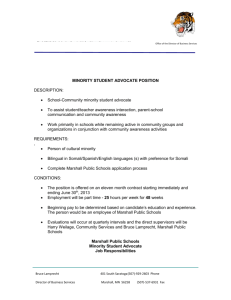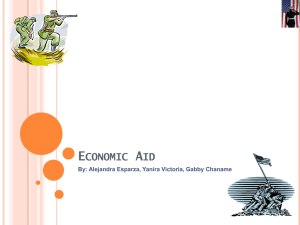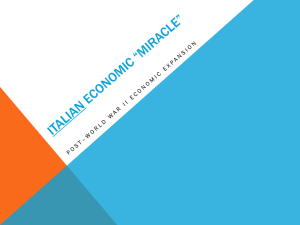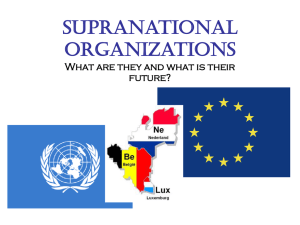THE ARAB SPRING SYNDROME ABSTRACT The Arab Spring
advertisement
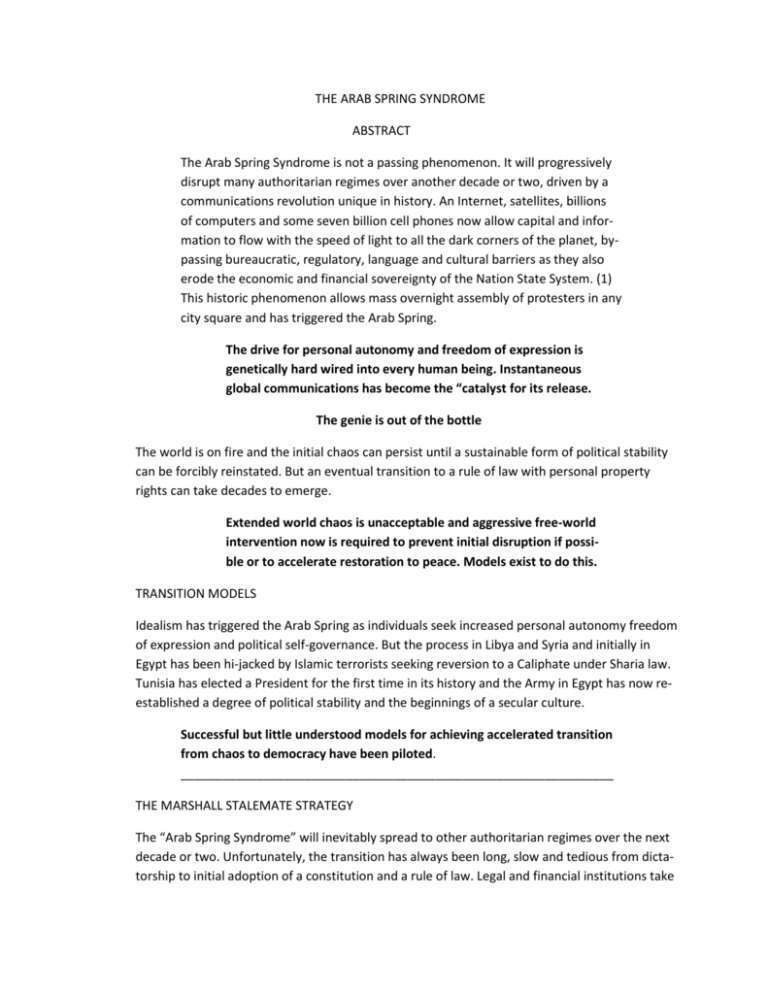
THE ARAB SPRING SYNDROME ABSTRACT The Arab Spring Syndrome is not a passing phenomenon. It will progressively disrupt many authoritarian regimes over another decade or two, driven by a communications revolution unique in history. An Internet, satellites, billions of computers and some seven billion cell phones now allow capital and information to flow with the speed of light to all the dark corners of the planet, bypassing bureaucratic, regulatory, language and cultural barriers as they also erode the economic and financial sovereignty of the Nation State System. (1) This historic phenomenon allows mass overnight assembly of protesters in any city square and has triggered the Arab Spring. The drive for personal autonomy and freedom of expression is genetically hard wired into every human being. Instantaneous global communications has become the “catalyst for its release. The genie is out of the bottle The world is on fire and the initial chaos can persist until a sustainable form of political stability can be forcibly reinstated. But an eventual transition to a rule of law with personal property rights can take decades to emerge. Extended world chaos is unacceptable and aggressive free-world intervention now is required to prevent initial disruption if possible or to accelerate restoration to peace. Models exist to do this. TRANSITION MODELS Idealism has triggered the Arab Spring as individuals seek increased personal autonomy freedom of expression and political self-governance. But the process in Libya and Syria and initially in Egypt has been hi-jacked by Islamic terrorists seeking reversion to a Caliphate under Sharia law. Tunisia has elected a President for the first time in its history and the Army in Egypt has now reestablished a degree of political stability and the beginnings of a secular culture. Successful but little understood models for achieving accelerated transition from chaos to democracy have been piloted. _______________________________________________________________ THE MARSHALL STALEMATE STRATEGY The “Arab Spring Syndrome” will inevitably spread to other authoritarian regimes over the next decade or two. Unfortunately, the transition has always been long, slow and tedious from dictatorship to initial adoption of a constitution and a rule of law. Legal and financial institutions take -2many years to evolve. All repressive dictatorships and State Capital Oligarchies now are vulnerable to disruption. (3 Attaturk and Pinochet kept the “lid on” for decades under severe military repression long enough to develop the institutional systems required. As a result, Turkey now has developed a secular economy, with the army under civilian control. In Chili, Pinochet was able to accept advice from University of Chicago Business School professors and incrementally opened the economy to foreign investment. Chili now is the only self-governing capitalistic democracy in Latin America! However, the most effective transition process resulted from General George Marshall’s “Stalemate Strategy, which he first articulated in his Marshall Plan speech at the 1945 Harvard Commencement. (4) Marshall pointed out that the Allies had made a serious mistake in pulling troops out of Europe after WW I, only to see hostilities resumed. This time he urged, we must leave our troops in Germany and Okinawa and never again allow fighting in those territories. Several stages are involved in the transition. (Figure I ) FIGURE I MARSHALL PLAN STALEMATE STRATEGY FIGHTING…..EXHAUSTION…..”STALEMATE”…..NEGOTIATION….. DEMOCRACY The transition from dictatorship to democracy is a multiple stage process. Once stalemate has occurred however, the possibility exists that it can be indefinitely sustained with free world help. U.S. troops in Okinawa prevented further fighting on the Pacific Rim and as a result, Japan, Taiwan and South Korea with Marshall Plan assistance and guidance, have all morphed into selfgoverning capitalistic democracies for the first time in 5,000 years. NATO troops in Germany maintained the Cold War stalemate. But it took about 30 years for the Berlin Wall to fall and for the Soviet Empire then to crumble. However, greater Europe also is now at peace for the first time in 5,000 years. Troops in Bosnia must remain until that transition to democracy can be complete and garrison troops in Southern Lebanon have so far protected that border with Israel. However, both Egypt and Syria remain in chaos. ISIS Jihadist elements now threaten the entire Middle East area. Ironically, Israel has created a de facto form of “stalemate” in Palestine where multiple entrepreneurial new small businesses have begun to multiply. These automatically appear whenever forms of political stability are sustainable. The Marshall Plan Stalemate model remains the best way to assist transition from dictatorship to forms of democracy, but it can also be accelerated. Once political stability has been established, the critical conditions required for development of a strong middle class need to be introduced. Successful models have been developed. -3A strong middle class is essential for sustaining a democracy Emergence of a middle class was the intent in both Iraq and in Afghanistan. Indefinite retention of garrison U.S troops in those countries was designed to replicate the successful Marshall stalemate-strategy with accelrated economic development. The process can be achieved through adoption of the INPACT Model of economic development, which has demonstrated remarkable success in several developing nations. The United States has a particularly important role in catalyzing the process. THE INPACT MODEL (5) The International Program for Acceleration of Commercial Technology (INPACT) was developed by the Technology Office in the U S. Department of Commerce during the Reagan Administration. It was designed to assist developing countries to accelerate their economic development through joint venture relationships between start-up businesses in those countries and large U.S. companies.(7) FIGURE II A MODERN MARSHALL PLAN FOR EMERGING ECONOTheTTheTThT The pilot model was the Bi-national R&D Foundation (BIRD-F) between the U.S. and Israel, which was so successful that it has since become the primary job and per-capita wealth-creating engine of the Israeli economy. Israel now has more entrepreneurs-per-capita than the U.S. The program was so successful that it was cloned in India and in several other countries. In India it initiated the “Bangalore Software Valley” back office support business, an annual $100 billion worldwide operation widely copied in Poland and in other developing countries. -4The INPACT system was modeled on the Limited Liability Corporation (LLC) form of collaboration, created in the early 1980’s by the Technology Office in the U.S. Department of Commerce. The LLC has now become the dominant form of business incorporation in the U.S. (6) It was designed to provide overnight incorporation of new businesses and easy access (through a collaborative structure) to critical missing skills and resources. This often was accomplished through partnership arrangements with larger organizations). The LLC model pays no taxes and also protects investors from liability and antitrust concerns. In International forms of collaboration, the model often by-passed many emerging-nation bureaucratic and regulatory barriers, while also uniquely providing the risk-capital needed. The first step in formation of each INPACT venture begins with creation of a professionally managed INPACT Office in each emerging country. Special operating disciplines and organizational structures are required. (7) A low cost operating staff needs to involve no more than 5 people, but the Director must be a native of the country, who speaks the language and knows the culture. He should have an advanced degree in Science or Engineering and a Master’s Degree in Business Administration. In addition, at least 5 to 10 years of industrial experience are needed, preferably in the U.S. The staff role is one of pro-actively searching out and screening promising investment opportunities which can be coupled with a U.S. or other developed-country company. Partners are selected for an active interest in the technology involved and with possession of complementary skills and resources. The initial success of the PACT Program in India stimulated the World Bank to provide a $100 million grant to immediately expand the program to ten different areas in India. The low visibility of small start-ups tends to be non-threatening to most large entrenched authoritarian regimes, which resent diversion of capital. The BIRD-F model avoided this concern by establishing a $110 million private sector-managed foundation from which the annual interest was used as seed capital. SUMMARY The “dream” now exists for the first time in 5,000 years for the emergence of a peaceful “Global Village” on Planet Earth. This possibility has resulted from the intermittent rise (and fall) of the great Nations of history over 5,000 years, resulting finally in emergence of an advanced technology-driven civilization (8) based on a rule of law and personal property rights, but one now also interconnected in real time. Unfortunately, about 80% of world populations still live in under-developed countries. But it is now conceivable that the centuries-old “dream of universal personalized-education and of a literate and educated world population might finally be allowed to emerge. -5It could be the best of all times WW II inadvertently thrust the U.S. into the unsought Leadership of the Free world and also into an unprecedented degree of global dominance (not only militarily, but also economically and tech technologically), which is unique in history. In its own enlightened self-interest, U.S leadership now may again be required to save civilization (at the 11th hour) from the barbarians. __________________________________________________________________ Hon. D. Bruce Merrifield, PhD Former Undersecretary U.S. Department of Commerce, Technology and Economic Affairs, Regan Administration Bladstrom Professor of Management, Entrepreneurship Wharton School of Business, Univ. of Pennsylvania. REFERENCES (1) Digital Education; MIT Technology Review, Vol.16 No.1, pp61-4, (2013); N. Augustine, Science Vol.30,Jan. 25, 2013; Appleby, Thonas and Walsh, “Digital Culture and Education” Vol. 2, No. 2. Pp124-7 (2010). “The Digital Education Communications Revolution.” D. Bruce Merrifield, Web Page Pridco.net.”Entrpreneurship.” (2) D. Bruce Merrifield, “Entrepreneurship in the Anthropocene Era; It Could be the Best Of Times” Amazon. (2014) (3) State Capitalism; “State Capitalism and the Crisis;” www.mckensey.com/insights/public.../state_capitalism_and_the_crisis.com; D. Bruce Merrifield “State Capitalism” (ibid 2) (4) The Marshall Plan. D. Bruce Merrifield. “A Modern Marshall Plan for Developing Economies”. J. Business Venturing, Vol. No. 5. No. 4; July, (1991) (5) INPACT; D. Bruce Merrifield “International Program for Acceleration of Technology.” Web Page, Pridco.net “Entrpreneurship.” (6) The Limited Liability Corporation, (LLC) Model. The Cooperative Research And Development Act of 1984; (7) Screening Methodologies; D. Bruce Merrifield “The Constraint Analysis” Web Page’ Pridco.net, “Entrepreneurship;” D. Bruce Merrifield, “Strategic Accounting For R&D” Research Technology Management, Jan-Feb, (2006) pp 9-13. (8) “Human Accomplishments;” Charles Murray, Harper Collins, Publishers; (2003)

